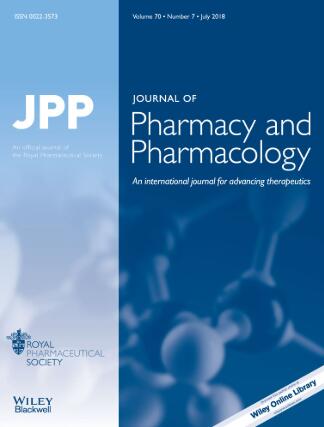小鼠肌肉注射低溶解度化合物的纳米和微晶制剂的药代动力学
IF 2.8
4区 医学
Q2 PHARMACOLOGY & PHARMACY
引用次数: 0
摘要
目的 本研究旨在探讨以不同大小的结晶颗粒形式肌肉注射(i.m.)时难溶性化合物的药代动力学(PK)。方法 将水溶性不同的三种不带电荷的化合物(格列齐芬、AZ'72 和 AZ'07)作为纳米和微粒制剂给小鼠注射,剂量分别为 10 和 50 mg/kg。对化合物的 PK 进行了评估。主要研究结果 药物颗粒越小,50 毫克/千克时的最大血浆浓度(Cmax)和血浆浓度-时间曲线下面积(AUC)越高。AUC的增加与剂量成正比,但Cmax的增加与剂量不成比例。10 毫克/千克剂量的评估更为复杂,因为只观察到溶解度最高的格列齐芬的纳米颗粒暴露量增加。此外,随着剂量的增加,半衰期也会延长。结论 本研究强调,根据体外溶解度得出的一般预期(即在液体包围下,较小颗粒的溶解速度比较大颗粒快)并不总是适用于体内,这表明了解药物的物理化学特性、制剂特性和给药部位的微观生理学非常重要。本文章由计算机程序翻译,如有差异,请以英文原文为准。
Pharmacokinetics of nano- and microcrystal formulations of low solubility compounds after intramuscular injection to mice
Objectives The aim of this study was to investigate the pharmacokinetics (PK) of poorly soluble compounds when administered intramuscularly (i.m.) as crystalline particles of different sizes. Methods Three uncharged compounds (griseofulvin, AZ’72, and AZ’07) with varying aqueous solubility were dosed to mice at 10 and 50 mg/kg as nano- and microparticle formulations. The PK of the compounds was evaluated. Key Findings The smaller particles of the drugs resulted in higher maximum plasma concentration (Cmax) and area under the plasma concentration–time profile (AUC) at 50 mg/kg. There was a dose-proportional increase in AUC but less than dose dose-proportional increase in Cmax. The evaluation at 10 mg/kg was more complex as increased exposure for nanoparticles was only observed for griseofulvin which has the highest solubility. In addition, there was an increase in half-life with an increase in dose. Conclusions This study highlights that general expectations based on in vitro dissolution (i.e. that smaller particles dissolve faster than larger particles when surrounded by liquid) do not always translate to in vivo and demonstrates the importance of understanding the physicochemical properties of the drug, the characteristics of the formulations and the microphysiology at the delivery site.
求助全文
通过发布文献求助,成功后即可免费获取论文全文。
去求助
来源期刊
CiteScore
6.60
自引率
0.00%
发文量
91
审稿时长
3 months
期刊介绍:
JPP keeps pace with new research on how drug action may be optimized by new technologies, and attention is given to understanding and improving drug interactions in the body. At the same time, the journal maintains its established and well-respected core strengths in areas such as pharmaceutics and drug delivery, experimental and clinical pharmacology, biopharmaceutics and drug disposition, and drugs from natural sources. JPP publishes at least one special issue on a topical theme each year.

 求助内容:
求助内容: 应助结果提醒方式:
应助结果提醒方式:


